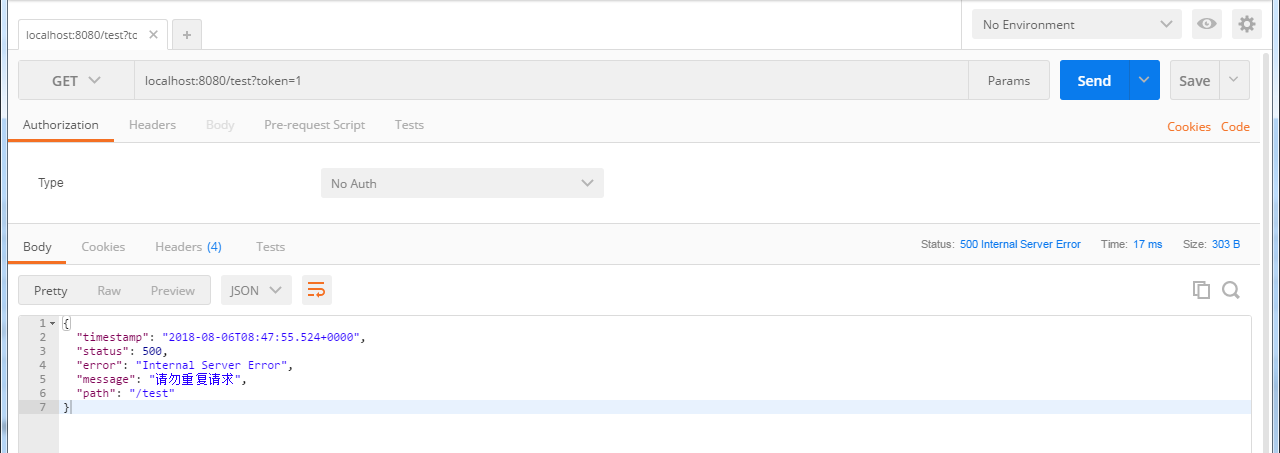springboot2本地锁实践一文中提到用Guava Cache实现锁机制,但在集群中就行不通了,所以我们还一般要借助类似Redis、ZooKeeper 之类的中间件实现分布式锁,下面我们将利用自定义注解、Spring Aop、Redis Cache 实现分布式锁。
项目代码结构整体图

一、导入依赖
在 pom.xml 中添加上 starter-web、starter-aop、starter-data-redis 的依赖
1 <dependencies>
2 <dependency>
3 <groupId>org.springframework.boot</groupId>
4 <artifactId>spring-boot-starter-web</artifactId>
5 </dependency>
6 <dependency>
7 <groupId>org.springframework.boot</groupId>
8 <artifactId>spring-boot-starter-aop</artifactId>
9 </dependency>
10 <dependency>
11 <groupId>org.springframework.boot</groupId>
12 <artifactId>spring-boot-starter-data-redis</artifactId>
13 </dependency>
14 </dependencies>
二、属性配置
在 application.properites 资源文件中添加 redis 相关的配置项
spring.redis.host=192.168.68.110
spring.redis.port=6379
spring.redis.password=123456
三、注解
1、创建一个 CacheLock 注解,属性配置如下
- prefix: 缓存中 key 的前缀
- expire: 过期时间,此处默认为 5 秒
- timeUnit: 超时单位,此处默认为秒
- delimiter: key 的分隔符,将不同参数值分割开来
1 import java.lang.annotation.*;
2 import java.util.concurrent.TimeUnit;
3
4 /**
5 * 锁的注解
6 */
7 @Target(ElementType.METHOD)
8 @Retention(RetentionPolicy.RUNTIME)
9 @Documented
10 @Inherited
11 public @interface CacheLock {
12
13 /**
14 * redis 锁key的前缀
15 *
16 * @return redis 锁key的前缀
17 */
18 String prefix() default "";
19
20 /**
21 * 过期秒数,默认为5秒
22 *
23 * @return 轮询锁的时间
24 */
25 int expire() default 5;
26
27 /**
28 * 超时时间单位
29 *
30 * @return 秒
31 */
32 TimeUnit timeUnit() default TimeUnit.SECONDS;
33
34 /**
35 * <p>Key的分隔符(默认 :)</p>
36 * <p>生成的Key:N:SO1008:500</p>
37 *
38 * @return String
39 */
40 String delimiter() default ":";
41 }
2、 key 的生成规则是自己定义的,如果通过表达式语法自己得去写解析规则还是比较麻烦的,所以依旧是用注解的方式
1 import java.lang.annotation.*;
2
3 /**
4 * 锁的参数
5 *
6 */
7 @Target({ElementType.PARAMETER, ElementType.METHOD, ElementType.FIELD})
8 @Retention(RetentionPolicy.RUNTIME)
9 @Documented
10 @Inherited
11 public @interface CacheParam {
12
13 /**
14 * 字段名称
15 *
16 * @return String
17 */
18 String name() default "";
19 }
四、Key生成策略
1、接口
1 import org.aspectj.lang.ProceedingJoinPoint;
2
3 /**
4 * key生成器
5 */
6 public interface CacheKeyGenerator {
7
8 /**
9 * 获取AOP参数,生成指定缓存Key
10 *
11 * @param pjp PJP
12 * @return 缓存KEY
13 */
14 String getLockKey(ProceedingJoinPoint pjp);
15 }
2、接口实现
import com.carry.annotation.CacheLock;
import com.carry.annotation.CacheParam;
import com.carry.common.CacheKeyGenerator;
import org.aspectj.lang.ProceedingJoinPoint;
import org.aspectj.lang.reflect.MethodSignature;
import org.springframework.util.ReflectionUtils;
import org.springframework.util.StringUtils;
import java.lang.annotation.Annotation;
import java.lang.reflect.Field;
import java.lang.reflect.Method;
import java.lang.reflect.Parameter;
/**
* 通过接口注入的方式去写不同的生成规则;
*/
public class LockKeyGenerator implements CacheKeyGenerator {
@Override
public String getLockKey(ProceedingJoinPoint pjp) {
MethodSignature signature = (MethodSignature) pjp.getSignature();
Method method = signature.getMethod();
CacheLock lockAnnotation = method.getAnnotation(CacheLock.class);
final Object[] args = pjp.getArgs();
final Parameter[] parameters = method.getParameters();
StringBuilder builder = new StringBuilder();
//默认解析方法里面带 CacheParam 注解的属性,如果没有尝试着解析实体对象中的
for (int i = 0; i < parameters.length; i++) {
final CacheParam annotation = parameters[i].getAnnotation(CacheParam.class);
if (annotation == null) {
continue;
}
builder.append(lockAnnotation.delimiter()).append(args[i]);
}
if (StringUtils.isEmpty(builder.toString())) {
final Annotation[][] parameterAnnotations = method.getParameterAnnotations();
for (int i = 0; i < parameterAnnotations.length; i++) {
final Object object = args[i];
final Field[] fields = object.getClass().getDeclaredFields();
for (Field field : fields) {
final CacheParam annotation = field.getAnnotation(CacheParam.class);
if (annotation == null) {
continue;
}
field.setAccessible(true);
builder.append(lockAnnotation.delimiter()).append(ReflectionUtils.getField(field, object));
}
}
}
return lockAnnotation.prefix() + builder.toString();
}
}
五、Lock拦截器(AOP)
熟悉 Redis 的朋友都知道它是线程安全的,我们利用它的特性可以很轻松的实现一个分布式锁,如 opsForValue().setIfAbsent(key,value)它的作用就是如果缓存中没有当前 Key 则进行缓存同时返回 true 反之亦然;当缓存后给 key 在设置个过期时间,防止因为系统崩溃而导致锁迟迟不释放形成死锁; 那么我们是不是可以这样认为当返回 true 我们认为它获取到锁了,在锁未释放的时候我们进行异常的抛出….
1 import com.carry.annotation.CacheLock;
2 import com.carry.common.CacheKeyGenerator;
3 import org.aspectj.lang.ProceedingJoinPoint;
4 import org.aspectj.lang.annotation.Around;
5 import org.aspectj.lang.annotation.Aspect;
6 import org.aspectj.lang.reflect.MethodSignature;
7 import org.springframework.beans.factory.annotation.Autowired;
8 import org.springframework.context.annotation.Configuration;
9 import org.springframework.data.redis.core.StringRedisTemplate;
10 import org.springframework.util.StringUtils;
11
12 import java.lang.reflect.Method;
13
14 /**
15 * redis 方案
16 */
17 @Aspect
18 @Configuration
19 public class LockMethodInterceptor {
20
21 @Autowired
22 public LockMethodInterceptor(StringRedisTemplate lockRedisTemplate, CacheKeyGenerator cacheKeyGenerator) {
23 this.lockRedisTemplate = lockRedisTemplate;
24 this.cacheKeyGenerator = cacheKeyGenerator;
25 }
26
27 private final StringRedisTemplate lockRedisTemplate;
28 private final CacheKeyGenerator cacheKeyGenerator;
29
30
31 @Around("execution(public * *(..)) && @annotation(com.carry.annotation.CacheLock)")
32 public Object interceptor(ProceedingJoinPoint pjp) {
33 MethodSignature signature = (MethodSignature) pjp.getSignature();
34 Method method = signature.getMethod();
35 CacheLock lock = method.getAnnotation(CacheLock.class);
36 if (StringUtils.isEmpty(lock.prefix())) {
37 throw new RuntimeException("lock key can't be null...");
38 }
39 final String lockKey = cacheKeyGenerator.getLockKey(pjp);
40 try {
41 //key不存在才能设置成功
42 final Boolean success = lockRedisTemplate.opsForValue().setIfAbsent(lockKey, "");
43 if (success) {
44 lockRedisTemplate.expire(lockKey, lock.expire(), lock.timeUnit());
45 } else {
46 //按理来说 我们应该抛出一个自定义的 CacheLockException 异常;
47 throw new RuntimeException("请勿重复请求");
48 }
49 try {
50 return pjp.proceed();
51 } catch (Throwable throwable) {
52 throw new RuntimeException("系统异常");
53 }
54 } finally {
55 //如果演示的话需要注释该代码;实际应该放开
56 // lockRedisTemplate.delete(lockKey);
57 }
58 }
59 }
六、控制层
在接口方法上添加 @CacheLock(prefix = "test"),然后动态的值可以加上@CacheParam;生成后的新 key 将被缓存起来;(如:该接口 token = 1,那么最终的 key 值为 test:1,如果多个条件则依次类推)
1 import com.carry.annotation.CacheLock;
2 import com.carry.annotation.CacheParam;
3 import org.springframework.web.bind.annotation.GetMapping;
4 import org.springframework.web.bind.annotation.RequestParam;
5 import org.springframework.web.bind.annotation.RestController;
6
7 @RestController
8 public class LockController {
9
10 @CacheLock(prefix = "test")
11 @GetMapping("/test")
12 public String query(@CacheParam(name = "token") @RequestParam String token) {
13 return "success - " + token;
14 }
15
16 }
七、主函数
需要注入前面定义好的 CacheKeyGenerator 接口具体实现…

1 import com.carry.common.CacheKeyGenerator;
2 import com.carry.common.LockKeyGenerator;
3 import org.springframework.boot.SpringApplication;
4 import org.springframework.boot.autoconfigure.SpringBootApplication;
5 import org.springframework.context.annotation.Bean;
6
7 @SpringBootApplication
8 public class SpringbootCacheRedislockApplication {
9
10 public static void main(String[] args) {
11 SpringApplication.run(SpringbootCacheRedislockApplication.class, args);
12 }
13
14 @Bean
15 public CacheKeyGenerator cacheKeyGenerator() {
16 return new LockKeyGenerator();
17 }
18 }
八、测试
启动项目,在postman中输入url:localhost:8080/test?token=1
第一次请求结果:

第二次请求结果:

等key过期了请求又恢复正常。